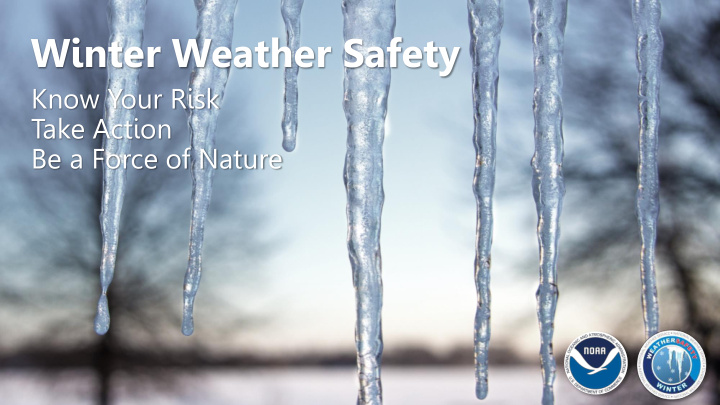



Winter Weather Safety Know Your Risk Take Action Be a Force of Nature
Winter Weather Safety Winter Weather Hazards • Snow and Sleet • Blizzards • Freezing Rain • Cold Temperatures • Strong Wind • Flooding • Fog weather.gov/safety
Winter Weather Safety Snow and Sleet • Snow and Sleet primarily affects travel, but can also damage infrastructure • Damage from winter storms exceeds $1 billion annually • The NWS will issue a winter storm warning or winter weather advisory weather.gov/safety
Winter Weather Safety Blizzards • Blizzards occur when strong winds cause blowing snow and whiteout conditions • Do not travel during a blizzard warning, especially in open country • The NWS will issue a blizzard warning weather.gov/safety
Winter Weather Safety Freezing Rain • Freezing rain affects travel and can knock out power • Have an emergency kit in case the power goes out • The NWS will issue an ice storm warning, or winter weather advisory weather.gov/safety
Winter Weather Safety NWS Winter Storm Products weather.gov/safety
Winter Weather Safety Cold Temperatures • Cold weather can cause frostbite or hypothermia • Dress in layers, cover exposed skin, and limit time outside • The NWS will issue a wind chill warning, wind chill watch, or wind chill advisory weather.gov/safety
Winter Weather Safety NWS Cold Weather Products weather.gov/safety
Winter Weather Safety How to Prepare • Check the forecast to get the latest weather news • Plan accordingly based on the expected weather conditions • Have a winter survival kit in your car if you must travel • Dress appropriately if you must go outside weather.gov/safety
Winter Weather Safety Winter Survival Kit • For your car: – Warm clothes, blanket, food, water, cell phone/charger • For your home: – Food, water, medication, flash light, first aid kit Ready.gov/build-a-kit weather.gov/safety
Winter Weather Safety Strong Wind • Powerful winter storms can bring strong winds that cause damage • Strong wind makes travel difficult, especially for large vehicles • Seek shelter in a sturdy structure during strong winds weather.gov/safety
Winter Weather Safety What to do When Driving • Slow down! • Keep two hands on the wheel • Distance yourself from trucks, buses, and vehicles towing trailers • Keep an eye out for debris, downed powerlines, and branches weather.gov/safety
Winter Weather Safety NWS High Wind Products weather.gov/safety
Winter Weather Safety Flooding • Flooding can be caused by heavy rain, snow melt, or ice jams • More than half of all flood fatalities are vehicle-related • Never drive through flood waters weather.gov/safety
Winter Weather Safety Ice Jams • Ice jam flooding occurs when chunks of ice build up and prevent water from flowing downstream • This can lead to rapid rises along upstream from the jam • Never drive through flood waters weather.gov/safety
Winter Weather Safety Debris Flows • Debris flows are possible when rain falls on steep terrain or burn scars • Soil, rocks, plants, and more may be swept downhill • Never drive around barricades weather.gov/safety
Winter Weather Safety NWS Flood Products weather.gov/safety
Winter Weather Safety Dense Fog • Dense fog poses a threat to motorists • Slow down • Leave plenty of space between you and the vehicle in front of you • Use your low-beam headlights weather.gov/safety
Winter Weather Safety NWS Dense Fog Products weather.gov/safety
Winter Weather Safety More Information • Visit the National Weather Service Safety pages – weather.gov/winter – weather.gov/cold – weather.gov/wind – weather.gov/flood – weather.gov/fog weather.gov/safety
Recommend
More recommend